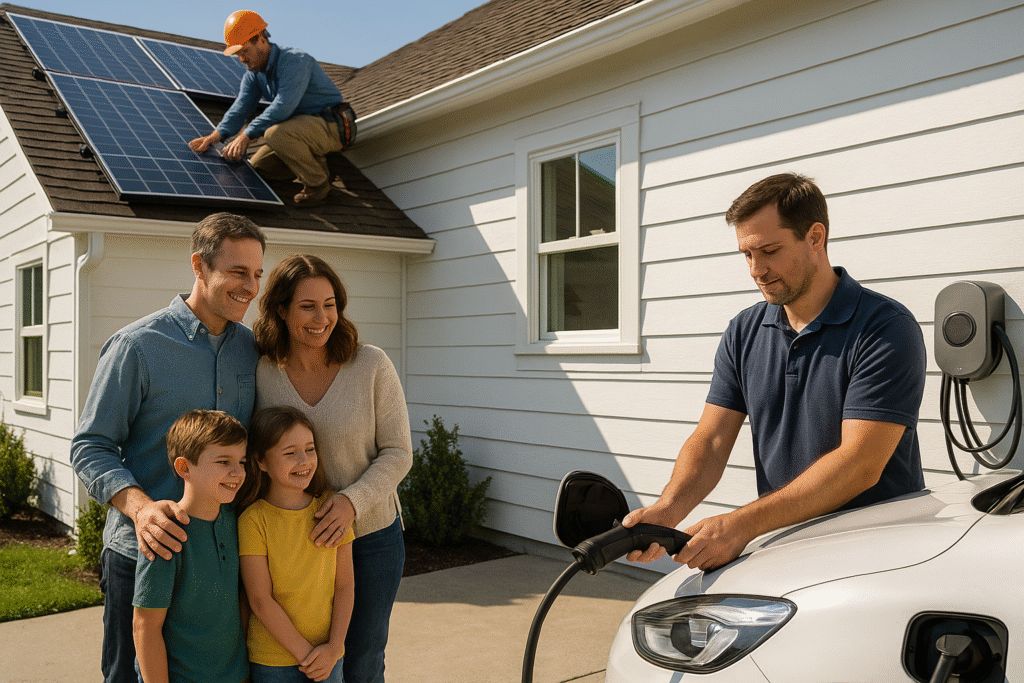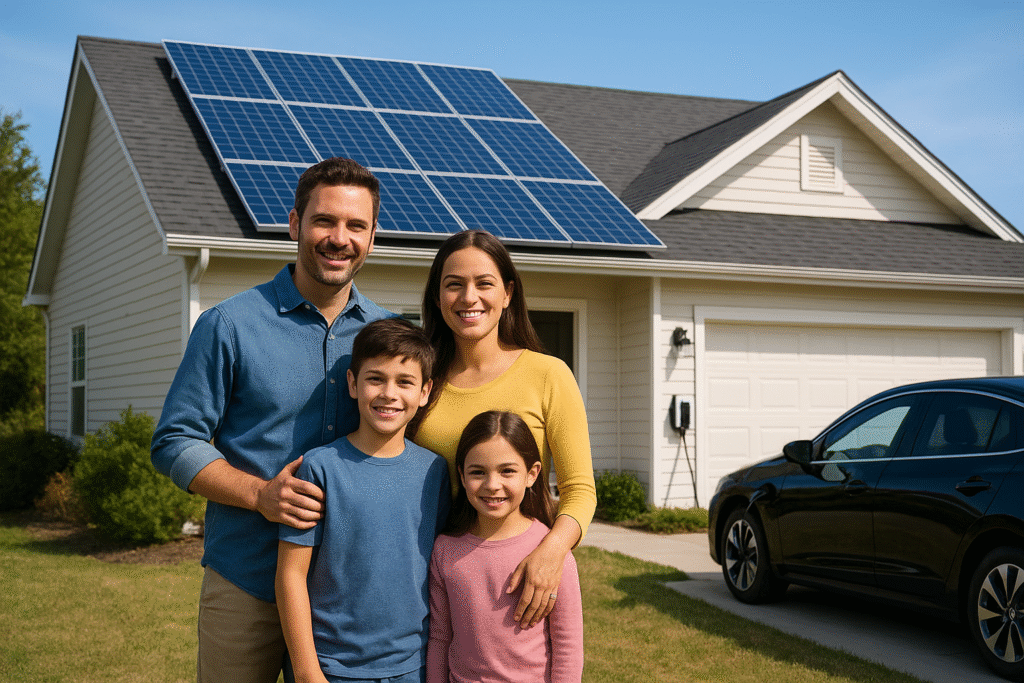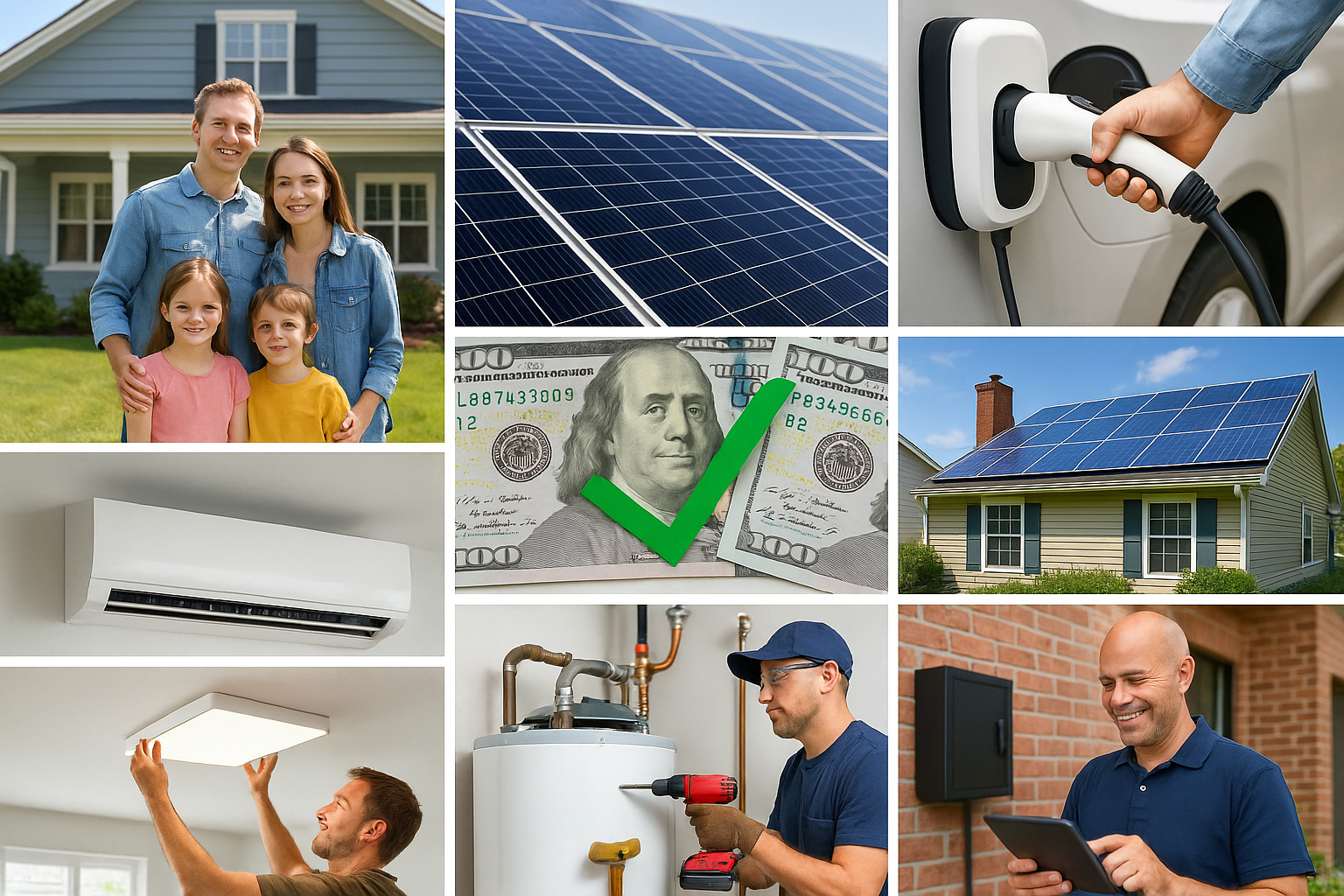Clean Energy Incentives Under the Inflation Reduction Act : Want to lower your utility bills, shrink your carbon footprint, and get cash help from the federal government to do it? The Inflation Reduction Act (IRA) dramatically expanded and extended clean-energy tax credits and incentives for homeowners, renters, landlords, and small businesses — from rooftop solar and heat pumps to home EV chargers and electric vehicles. This step-by-step, action-oriented guide shows you how to qualify, apply, and stack incentives the right way so you keep more of the savings.
Quick overview — what this guide covers
- Which federal credits commonly help households and small businesses (solar, heat pumps, EV chargers, vehicles, efficiency).
- Simple eligibility checks and documentation you’ll need.
- How to claim credits on your tax return — or use dealer/contractor point-of-sale options where available.
- Smart stacking: combining tax credits, local rebates, and utility incentives.
- Official links you can click for each credit and program to verify details.
The foundation: Which credits matter most for families & small businesses?
Here are the core federal incentives families and small businesses should know about (short list):
- Residential Clean Energy Credit — for rooftop solar, battery storage, small wind, and certain geothermal systems. (IRS)
- Energy Efficient Home Improvement Credit (aka expanded Section 25C / “home improvements” credit) — insulation, windows, heat pumps, heat-pump water heaters, and home energy audits. (IRS)
- Alternative Fuel Vehicle Refueling Property Credit — for installing EV chargers at your home or business (also for some commercial charging). (IRS)
- Clean Vehicle Credit — up to $7,500 for qualifying new electric vehicles (EVs) and related rules for used EVs and point-of-sale options with dealer reporting. (IRS)
- Rules on vehicle final assembly and battery sourcing — to qualify for the vehicle credit, the vehicle often must have final assembly in North America and meet battery component rules (see DOE/AFDC guidance). (Alternative Fuels Data Center)
I’ll explain applied steps for each of these and how families and small businesses can take advantage.
Step 1 — Quick eligibility checklist (do this first)
Before you schedule contractors or sign an EV order, answer these quick checks:
- Is the property the taxpayer’s primary residence (many residential credits require U.S. primary residence)? If you’re a landlord or small business, other rules apply — read the business credit guidance.
- Will the equipment be new and placed in service (not used)? Most IRA credits require new equipment placed in service within the covered dates.
- Do you have access to receipts, invoices, and a manufacturer’s certificate of compliance (for windows, heat pumps, etc.)? Keep paperwork.
- Are you purchasing an EV that meets final assembly and income/MSRP rules for the clean vehicle credit? Check the vehicle’s eligibility list before you buy. (IRS, Alternative Fuels Data Center)
If you can answer “yes” where required, you’re ready to move to the next steps.

Step 2 — Home electrification & solar (biggest wins for many households)
What’s available
- Residential Clean Energy Credit: 30% of qualified installation costs for solar panels, certain battery storage systems, small wind, and geothermal heat pumps for systems placed in service through 2032 (phases down in later years). This credit now includes more kinds of battery storage when paired with solar. (IRS)
- Energy Efficient Home Improvement Credit: Covers a portion of costs for improvements like certified heat pumps, water heaters, insulation, windows and doors, and certain energy audits. Many categories are 30% of cost with annual caps for some items through 2032. (IRS)
How to claim
- Collect documentation: contractor invoice (itemized labor and parts), proof of payment, product manufacturer certification (if applicable).
- Check applicable caps: some items under the home improvement credit have per-item caps (e.g., windows), while heat-pump equipment may be capped differently. See the IRS guidance for exact dollar limits. (IRS)
- File Form 5695 with your federal return to claim residential clean energy and home energy credits — or follow the IRS instructions for each credit. Keep records for at least three years.
Pro tips
- Ask your contractor if they participate in direct pay / transferability options (certain entities and projects may use different administrative rules). For most homeowners, the tax credit reduces taxes owed or increases refund via Form 5695. Keep invoices that separate parts and labor (labor for on-site installation of solar/heat pumps is generally eligible for the credit). (IRS)
Step 3 — EVs & chargers: buy smart, claim faster
New and used EV tax credits
- New Clean Vehicle Credit (up to $7,500) — applies to qualifying new EVs purchased 2023–2032. Eligibility depends on where the vehicle is assembled, battery sourcing rules, MSRP caps for various vehicle types, and purchaser income limits. Check the IRS clean vehicle credit page and the DOE vehicle lists for model eligibility before you buy. (IRS, Alternative Fuels Data Center)
- Used EV Credit (up to $4,000 or 30% of price, whichever is less) — for qualifying used clean vehicles (income and price caps apply). (IRS)
Chargers (home & business)
- Alternative Fuel Vehicle Refueling Property Credit: For home EV chargers, residential taxpayers can claim 30% of the cost (including installation labor) up to a $1,000 credit per charging port (rules and caps differ slightly for businesses and non-profits). Businesses often use a related business credit or elective payment options. (IRS)
How to claim & point-of-sale option
- Before purchase: Confirm vehicle eligibility on the IRS/DOE lists and confirm dealer reporting requirements — sellers must provide documentation for buyer claims. Dealers can provide point-of-sale reductions in some cases (instant credit at dealer) but the process differs by dealer and product. (IRS)
- For chargers: Keep invoices and proof of payment; claim the charging station credit on your tax return per IRS rules. Businesses should consult a tax advisor for the correct business credit form. (IRS)

Step 4 — Small business & commercial opportunities
Small businesses can benefit too — not just homeowners.
- Business investment credits (like the energy investment tax credits and production credits) and elective pay / transferability rules allow some companies to monetize credits more flexibly (choose to transfer credits or receive a direct payment in specific cases). The IRA expanded transferability/transfer rules and elective payment options in some programs — check IRS guidance and Treasury notices for specifics and timelines. (IRS)
- Commercial EV charger and clean energy installations: Businesses can use business tax provisions to write off or claim credits for workplace EV chargers, rooftop solar on business property, and energy storage paired with business infrastructure. See AFDC and IRS pages for eligible property and how to claim. (Alternative Fuels Data Center, IRS)
Action for small businesses: meet with your CPA or tax advisor — business rules (basis adjustments, depreciation, elective pay decisions) are detailed and often time-sensitive.
Step 5 — Stack local, state, and utility incentives with federal credits
Federal credits are powerful, but utility rebates, state incentives, and local programs can cut your net cost even further.
- Start at your state energy office or local utility: many utilities offer point-of-sale rebates for heat pumps, discounts for insulation, or reduced rates for EV charging during off-peak hours.
- Layering rules: Most federal credits allow you to combine federal tax credits with state or local rebates — but read both program rules carefully. Some rebate programs require you to reduce the federal credit basis by the rebate amount (check IRS guidance and program terms).
- Use aggregator tools (State energy office databases, DSIRE, or your utility pages) to find incentives in your zip code.
Step 6 — Paperwork & timing: avoid common mistakes
- Save itemized invoices that break out equipment vs. labor (labor for on-site installation is generally eligible for home energy and solar credits). (IRS)
- Verify product certifications: many credits require equipment meeting federal energy-efficiency standards or manufacturer certifications.
- Confirm installation date: credits are claimed for the year the equipment is placed in service. Plan installation timing with your tax year if you’re balancing other tax moves.
- Keep contractor credentials: ask contractors for proof of business license and warranty details — it helps during audits or documentation requests.
Step 7 — Best order to act (recommended sequence)
- Estimate your total project cost and research federal/state incentives (use the official IRS pages and state resources).
- Request multiple bids from contractors who understand IRA credits and will provide compliant invoices. Ask about labor inclusion and manufacturer compliance paperwork.
- Confirm vehicle eligibility (if buying an EV) with the dealer and ask them to provide the required buyer/seller reporting forms. (IRS)
- Schedule installation and secure documentation when the work is completed.
- Claim credits on your tax return (Form 5695 for residential clean energy & home improvements; see IRS pages for forms for EVs and charging station credits). Keep copies of everything.
Example: family installs solar + home heat pump (simple numbers)
- Solar system cost (installed): $25,000
- Heat pump (air source) installed: $10,000
- Residential Clean Energy Credit (solar): 30% × $25,000 = $7,500. (IRS)
- Energy Efficient Home Improvement Credit (heat pump qualifies at 30% up to limits): 30% × $10,000 = $3,000 (subject to annual caps/limits — check IRS tables). (IRS)
Rough federal tax credit total = $10,500 (before considering state/utility rebates). Net cost after credits = $24,500. Keep receipts and file Form 5695. This example is simplified — actual caps and phaseouts may apply; verify the precise limits for your tax year. (IRS)
Step 8 — Where to verify official program rules (click to go)
Use the official sources below to verify details, download forms, and find model/equipment lists. These are live government pages as of Aug 2025:
- Residential Clean Energy Credit (IRS) — details, eligible property, and Form 5695 instructions. (IRS)
https://www.irs.gov/credits-deductions/residential-clean-energy-credit - Energy Efficient Home Improvement Credit (IRS) — which improvements qualify, caps, and FAQs. (IRS)
https://www.irs.gov/credits-deductions/energy-efficient-home-improvement-credit - Clean Vehicle Credit (IRS) — eligibility rules for new and used clean vehicles, dealer reporting, and claiming the credit. (IRS)
https://www.irs.gov/clean-vehicle-tax-credits - Alternative Fuel Vehicle Refueling Property Credit (IRS) — residential and commercial charging station guidance and limits. (IRS)
https://www.irs.gov/credits-deductions/alternative-fuel-vehicle-refueling-property-credit - DOE / AFDC — Final assembly & vehicle lists — check whether a vehicle’s final assembly and battery sourcing meet credit rules. (Alternative Fuels Data Center)
https://afdc.energy.gov/laws/electric-vehicles-for-tax-credit - EnergyS tar / Federal tax credits page — consumer-friendly summary of federal tax credit opportunities. (ENERGY STAR)
https://www.energystar.gov/about/federal_tax_credits
Common pitfalls & how to avoid them
- Buying an EV without confirming eligibility: many MSRP/income and assembly rules apply—check the DOE/IRS lists first. (Alternative Fuels Data Center, IRS)
- Relying on verbal assurances from contractors: always get written, itemized invoices and product certification statements. (IRS)
- Missed documentation in a tax year: credits apply when equipment is placed in service, so don’t assume ordering a product is enough—installation date matters.
- Failing to coordinate with utility/state rebates: some rebate programs have preapproval steps; check rules so you don’t lose local incentives.
Final checklist — before you act
- Confirm product eligibility (DOE/AFDC and IRS lists for EVs, solar, heat pumps). (Alternative Fuels Data Center, IRS)
- Get at least two contractor bids that include itemized labor and equipment.
- Lock in installation schedule and confirm “placed in service” date.
- Save all receipts, manufacturer certifications, and warranty paperwork.
- If buying an EV, confirm dealer reporting and point-of-sale credit options or plan to claim on your tax return. (IRS)
- Claim credits on your federal tax return (Form 5695 and applicable forms for EVs/chargers) and consult a tax pro for business claims.
Disclaimer
This post is informational only and does not constitute tax, legal, or financial advice. Clean-energy tax credits and vehicle eligibility rules are detailed and change periodically; always confirm program rules, dollar limits, equipment lists, and filing requirements with the official IRS and DOE pages linked above before acting. If you have complex circumstances (business claims, high net worth, multiple properties), consult a qualified tax advisor. All images used in this article are royalty‑free or licensed for commercial use and are provided here for illustrative purposes.
